#Nyasasaurus
Explore tagged Tumblr posts
Text
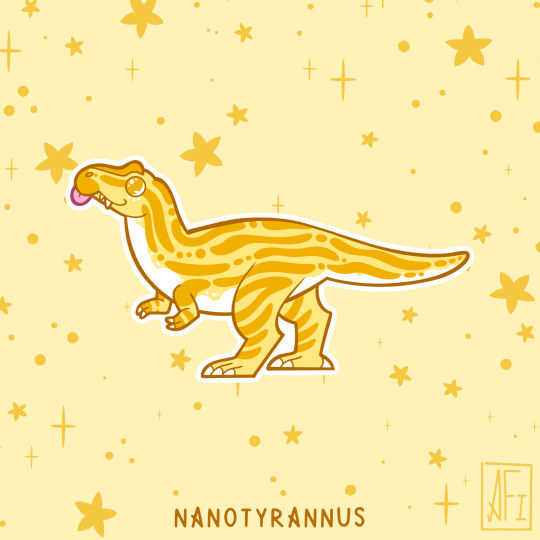

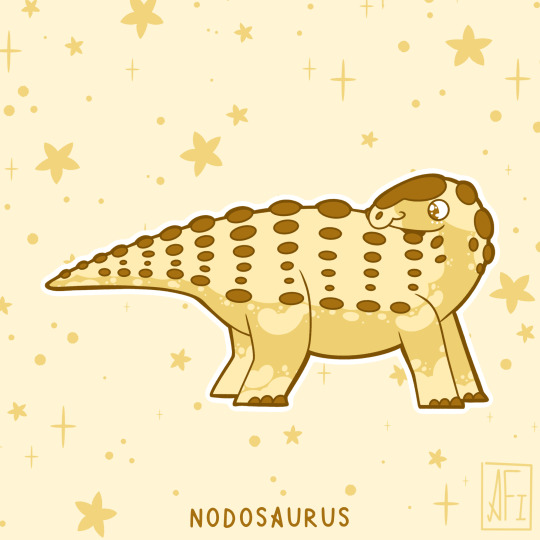
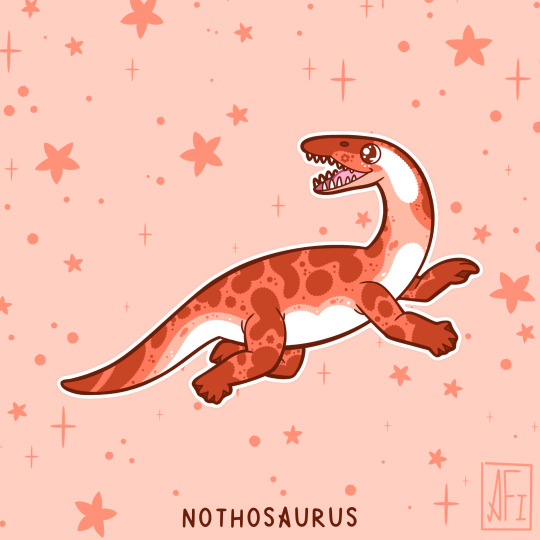
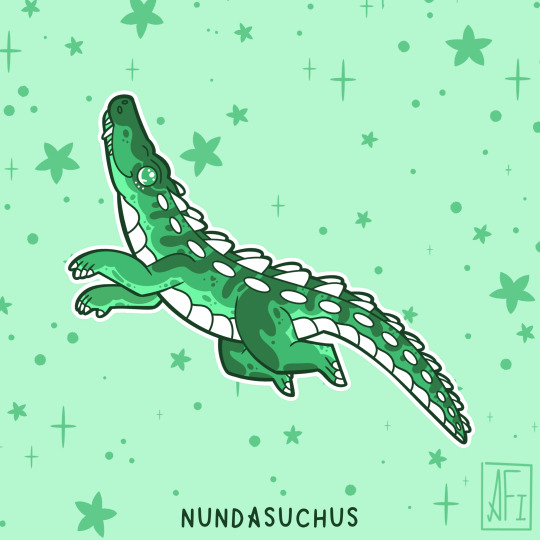



N is for...?
All of the N names in my Paleo Party! Are there any I'm missing? Surprisingly thus far I only have Mesozoic critters in this section!
Stickers || Phone Wallpapers Masterlist
#art#my art#paleoart#paleontology#science#illustration#dinosaur#nyasasaurus#nasutoceratops#nyctosaurus#nundasuchus#nothosaurus#nanotyrannus#nanuqsaurus#nodosaurus
37 notes
·
View notes
Text

Nyasasaurus & Meganeura.
This was a little experiment with colours and thicker lines. I need some more practice, as it separates the creatures from the background too well, making them seem 'pasted on', while I'd like it to feel more cohesive. Ah well, next time!
12 notes
·
View notes
Text

pluto and charon as nyasasaurus!
nyasasaurus was a genus of avemetatarsalian archosaur from the middle triassic manda formation of tanzania! (avemetatarsalian basically means they are more closely related to birds than to crocodillians!) these little three foot critters were herbivores! neat little guys :)
their name literally means "lake nyasa lizard"
#my art#solarballs#solarballs fanart#dinosaurs#nyasasaurus#solarballs pluto#solarballs charon#pluto#charon
8 notes
·
View notes
Text

A 10m longboi
3 notes
·
View notes
Text
Random Dino Facts #5
The title of earliest known dinosaur goes to Nyasasaurus Parringtoni, found near Lake Nyasa in Tanzania sometime in the 1930’s.

This creature lived roughly 245 million years ago, predating other dinosaurs by 10-15 million years. The significance of this species was not realised until a study in 2013 classified it as a basal dinosaur instead of an archosaur.

It was originally named Thecodontosaurus Alophos in 1932 before further examination showed it to be a completely different genus. After this it was almost completely ignored by the palaeontology community until 2013 due to the almost complete lack of fossils, with only one humerus and eleven vertebrae. Due to the lack of fossils, we do not know what the creature ate.
The study:
2 notes
·
View notes
Note
To Shelly,
How many dinosaur facts do you even know? I know a few but id always love to hear more facts!

[Shelly] "Thanks for...wanting to listen...to my facts..rr...."
"A study suggests that....Nyasasaurus may be the earliest known dinosaur, dating to the late Anisian stage, about 243 million years ago, 10 to 15 million years older than any previously described dinosaur, such as Herrerasaurus...."
"I know that...you might already know this...but Chickens are actually descendants of dinosaurs....from the are part of a group of birds that evolved from theropod dinosaurs, a group of two-legged dinosaurs....!"
"And last...but not least...The heaviest dinosaur was Argentinosaurus at 77 tonnes. It was the equivalent to 17 African Elephants. Argentinosaurus is a double award winner being also the longest dinosaur. It is also the largest land animal to have ever lived...."
"...That's all...for now...thanks again for...listening..."
#dandys world survival! au#dandys world#dandysworld#dandy's world fanart#dandys world shelly#twisted shelly#team cleans o' joy#dandys world roblox#dandys world twisted#shelly dandys world#dandy dandys world#dandys world fanart#roblox dandys world#roblox fanart#roblox art#roblox#roblox game
27 notes
·
View notes
Text

DINOVEMBER 1/13: Gondwanax paraisensis
Hello everyone! I'm doing Dinovember again this year, but a little differently. I'll only be doing 3 drawings a week (ish) in order to pace myself, as in past years going the full 30 hasn't worked for me. As per usual, I'll be following my own list which is sorted oldest-youngest, with the focus this year being on new discoveries.
Talking of new discoveries, Gondwanax was only described in September this year from a femur (and other potentially assignable scraps) found in Brazil's Santa Maria formation. Gondwanax was one of the oldest known dinosauromorphs at 240Ma-230Ma, rivalling animals like Nyasasaurus, the closely related Asilisaurus from Tanzania and furthering our knowledge of the origins of dinosauria.
Gondwanax has been identified as a silesaur, a group of primarily herbivorous archosaurs which it looks increasingly like are actually the long sort-after Triassic representatives of the ornithischian dinosaurs. The phylogeny of Gondwanax published in it's description supports this, placing it and the rest of "silesauridae" as grading from basal dinosauria into crown ornithischia.
#Gondwanax#triassic#dinosaurs#palaeontology#palaeostuff#palaeoblr#paleoart#paleontology#palaeoart#dinovember#dinovember 2024#anthem posts#anthems art#silesaur#n class
43 notes
·
View notes
Text
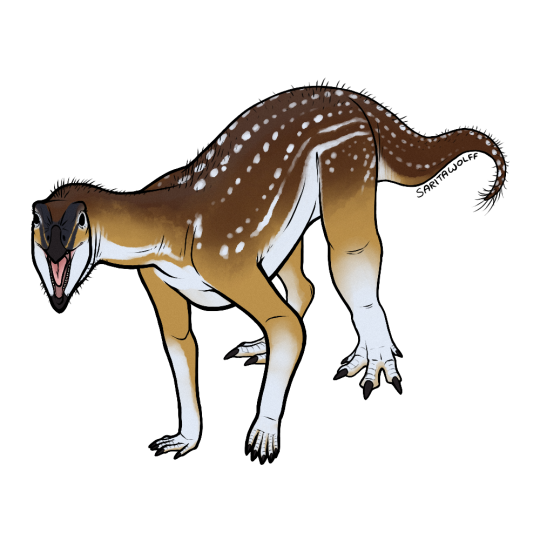
Patreon request for @/rome.and.stuff (Instagram) - Asilisaurus kongwe
Asilisaurus kongwe means “Ancient Ancestor.” As one of the first silesaurs, Asilisaurus is one of the oldest-known Avemetatarsalians (the clade which includes dinosaurs, silesaurs, and pterosaurs.) Found in the Manda Formation of Tanzania, it lived during the earliest portion of the Late Triassic. It appears to have been very common (or at least very prone to fossilization) as it is known from a relatively large amount of fossils.
Based on the length of its limbs, Asilisaurus was likely quadrupedal, but probably could have also reared up on its hind legs. It had no teeth in the tip of its snout, indicating the presence of a small beak, and also had fewer teeth than other silesaurs. Because of this, it is hypothesized that Asilisaurus was an omnivore or even a herbivore. The peglike shape of its teeth may have also lended to piscivory. As silesaurs seemed to have diets which were just as varied as dinosaurs (the Argentinian Lewisuchus was a specialized carnivore, the North American Kwanasaurus was an obligate herbivore, and the Polish Silesaurus was an insectivore and herbivore), Asilisaurus’ diet can’t be based on phylogenetic bracketing.
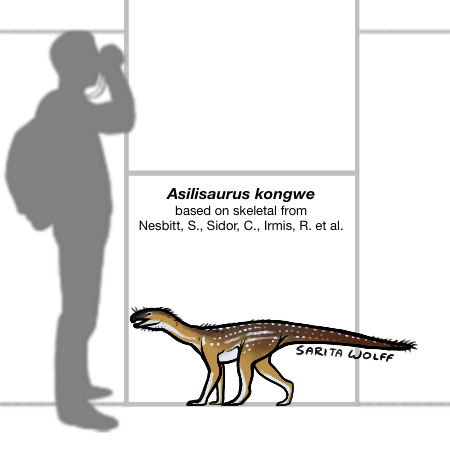
There seem to be two different adult morphologies of Asilisaurus: a “slender” form and a “robust” form. While traditionally regarded as a sign of sexual dimorphism, newer studies show that this could have simply been individual variation and a difference of growth in plentiful vs depleted environments (ie epigenetics), similar to differences seen in Plateosaurus and the modern Alligator.
In the Early Carnian of Tanzania, Asilisaurus kongwe would have lived alongside a variety of pseudosuchians such as Nundasuchus and Mambawakale, as well as the possible early dinosaur, Nyasasaurus. The environment was rich in synapsids as well, including dicynodonts like Angonisaurus, Kannemeyeria, and Tetragonias, and cynodonts like Cynognathus and Diademodon. Asilisaurus would have been preyed on by the aphanosaur Teleocrater and possibly some of the larger, carnivorous cynodonts, which is why I have given it spots for camouflage!
#Asilisaurus kongwe#Asilisaurus#silesaurs#silesaurids#archosaurs#archosauromorphs#reptiles#Manda Formation#Tanzania#Middle Triassic#Late Triassic
64 notes
·
View notes
Text
Trivia Tuesday
16 notes
·
View notes
Text
picking these 10 was very difficult there are too many triassic weirdos and I'm not even touching the sea right now
125 notes
·
View notes
Text

Nyasasaurus is a dinosaur.
10 notes
·
View notes
Text


















My Mesozoic is Blue 💙💙💙
Nyasasaurus - Hatzegopteryx - Maiasaurus
Liopleurodon - Unenlagia - Qianzhousaurus
Sarcosuchus - Sinomacrops - Vallibonavenatrix
Majungasaurus - Maip macrothorax - Arkansaurus
Gastonia - Styracosaurus - Ankylosaurus
Troodon (?) - Megalosaurus** - Brachiosaurus
Stickers || Phone Wallpapers Masterlist
**Megalosaurus is in my updates list. Gotta take care of those broken wrists by the time their discovery day comes around next year!
#art#my art#paleoart#paleontology#science#illustration#dinosaur#troodon#megalosaurus#brachiosaurus#gastonia#styracosaurus#ankylosaurus#majungasaurus#maip#maip macrothorax#arkansaurus#sarcosuchus#sinomacrops#vallibonavenatrix#liopleurodon#unenlagia#qianzhousaurus#nyasasaurus#maiasaura#hatzegopteryx
91 notes
·
View notes
Text
Life in the Middle Triassic
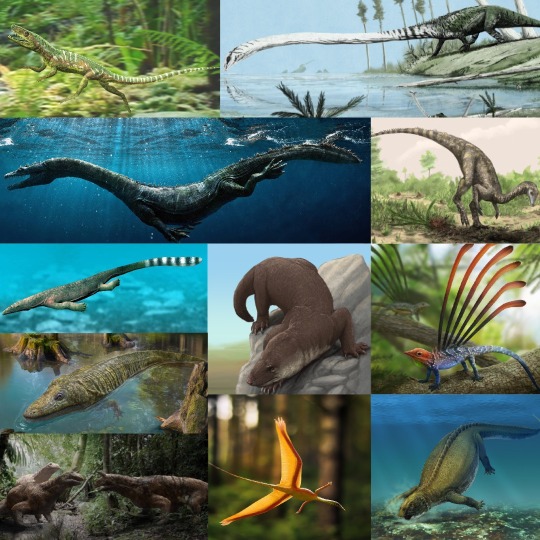
(first row: Euparkeria, Tanystropheus; second row: Nothosaurus, Nyasasaurus; third row: Thalattosaurus (top), Mastodonsaurus (bottom), Cynognathus, Longisquama; fourth row: Shringasaurus, Sharovipteryx, Placodus)
Art by:
Tanystropheus, Nyasasaurus - Mark Witton
Thalattosaurus - Nobu Tamura
Nothosaurus - Johnson Mortimer
Mastodonsaurus - Vladislav Egorov
Sharovipteryx, Longisquama - Julio Lacerda
Shringasaurus - Ntvtiko
Cynognathus - Gabriel Ugueto
Euparkeria - Taenadoman
Placodus - Sergey Krasovsky
The Triassic is a fantastic time if you’re interested in weird creatures and it’s a shame that it often gets overlooked in favor of the more dinosaur-rich Jurassic and Cretaceous. The main reason for the abundance of Triassic weirdos is that the time period was bookended on both sides by mass extinctions: The end Permian mass extinction had just left the planet empty, with lots of opportunities for evolution to go crazy as the the few survivors refilled niches. At the end of the Triassic however (Spoiler alert), another mass extinction wiped out most of the newly established forms, which is why they look so foreign and strange to us - bizarre anomalies that only existed for a brief period of time and didn‘t leave any successors to help us understand them better.
One of those weirdos is leg-winged Sharovipteryx. Because yes, while every other vertebrate on the planet decided that arms are pretty good for flying, Sharovipteryx wanted to not be like other girls and used its legs instead. While it wasn‘t capable of powered flight (only birds, bats and pterosaurs ever accomplished that), it was probably a decent glider (Dyke, 2006).
From the same fossil beds as Sharovipteryx comes another unusual critter: Longisquama. At first glance it might look like your typical little lizard - if it wasn‘t for its back being covered with those long …scales? Feathers? Maybe just plant leaves that somehow fossilzed next to the animal? We really are not sure what exactly is going on with the back of this little guy. Although it seems like the most recent idea is, that those appendages are not feathers in the sense that birds have them, but that both feathers and Longisquama‘s structures might be homologous, meaning that they come from the same origin (Buchwitz, 2012). As for what were they doing with the structures? Probably sexual display, which is the paleontology version of saying “we‘re not sure, but unless you‘ve got a better idea, we‘re sticking with this one“.
(Oh, and btw both Longisquama and Sharovipteryx are prime topics for David Peters, self-proclaimed paleontologist that apparently loves to spread misinformation and seems to have beef with the entire paleo-community - so be cautious when you see something written by him. Man, I really don‘t wanna be involved with paleo drama. I wasn‘t even aware there was paleo drama)
The placement of both Sharovipteryx as well as Longuisquama on the family tree is pretty uncertain, but most likely they fall somewhere around the base of the Archosaur lineage, a group that you will hear a lot about in the future, as it includes the flying pterosaurs, everything related to crocodiles, and of course the dinosaurs. The earliest of those you might see around this time in the form of medium-sized average-looking bipeds like Nyasasaurus.
Also settled around the base of the archosaur line is long necked Tanystropheus (although some of its fossils were believed to be flying pterosaurs for a long time because its neck vertebrae were mistaken for wing finger bones). With a length of around 5 m it was pretty big for the time. It most likely lived a semi-aquatic lifestyle, staying on the shores while it used it oversized neck to catch fish from the water.
During the Triassic we see quite a few reptile groups going for more aquatic lifestyle. While some, like the Thalattosaurs were relatively short-lived, others dominated for most of the age of reptiles. One of the most prominent groups are the Sauropterygia. The name (which translates to “lizard flippers“) might not sound too familiar, but this is the group that will later contain the Loch-Ness-monster looking plesiosaurs and their shorter-necked cousins, the pliosaurs. In the early days of this group the animals weren‘t quite as well adapted for the waters yet, but you can already see were the journey is going. Nothosaurus for examples, lived probably similar to seals, while Placodus was more terrestrial and only spent time in the water to forage for food.
Most of this was all very reptile-focused. That is because by now the synapsids, those early cousins of our own lineage, that roamed the world as giant beasts during the permian, had lost their positions at the top of the food chain. For the most part, they were now constrained to small burrows and dark nights, to the shadows of much larger creatures. Their story does of course not end here, but for the next 170 million years our planet truely was a planet of reptiles.
3 notes
·
View notes
Text
Investigadores de la University College London sugieren que los primeros dinosaurios pudieron originarse en el supercontinente Gondwana, millones de años antes de los fósiles más antiguos conocidos. Los autores del estudio indican que estos reptiles surgieron en un entorno cálido y seco, posiblemente en regiones que hoy comprenden el Amazonas y partes de África. El Nyasasaurus podría ser el dinosaurio más antiguo conocido o bien un pariente cercano de los primeros dinosaurios. / Mark Witton/Patronos del Museo de Historia Natural, Londres Los restos de los primeros dinosaurios podrían yacer sin descubrir en el Amazonas y otras regiones ecuatoriales de Sudamérica y África, sugiere un estudio de modelización dirigido por investigadores de la University College London, que apunta, además, a un origen millones de años anterior. En la actualidad, los fósiles de dinosaurio más antiguos que se conocen datan de hace unos 230 millones de años y fueron desenterrados más al sur, en lugares como Brasil, Argentina y Zimbabue. Pero las diferencias entre estos fósiles sugieren que los dinosaurios ya habían estado evolucionando durante algún tiempo, lo que apunta a un origen millones de años antes, señalan los investigadores. El trabajo, según la universidad británica (UCL), es un “nuevo giro en el misterioso origen de los dinosaurios”; los resultados se publican en la revista Current Biology. Este ha tenido en cuenta las lagunas existentes en el registro fósil, llegando a la conclusión de que los primeros dinosaurios probablemente surgieron en una región ecuatorial cálida en lo que entonces era el supercontinente Gondwana. Esta zona de tierra hoy abarca el Amazonas, la cuenca del Congo y el desierto del Sáhara, explica un comunicado de la UCL. Grandes lagunas en los registros “Los dinosaurios están bien estudiados, pero aún no sabemos realmente de dónde proceden. El registro fósil presenta lagunas tan grandes que no puede tomarse al pie de la letra”, indica Joel Heath. “Nuestro modelo sugiere que los primeros dinosaurios podrían haberse originado en Gondwana, una zona occidental de baja latitud. Se trata de un entorno más cálido y seco de lo que se pensaba, formado por zonas desérticas y sabanas”, añade. Hasta ahora, no se han encontrado fósiles en las regiones de África y Sudamérica que en su día formaron esta parte de Gondwana. Sin embargo, “esto podría deberse a que los investigadores aún no se han topado con las rocas adecuadas, debido a una mezcla de inaccesibilidad y relativa falta de esfuerzos de investigación en estas zonas”. El estudio de modelización se basó en fósiles y árboles evolutivos de dinosaurios y sus parientes reptiles cercanos, así como en geografía de la época. Al principio, los primeros dinosaurios eran superados ampliamente en número por sus primos reptiles, entre ellos los antepasados de los cocodrilos, los pseudosuquios (un abundante grupo que incluía especies enormes de hasta 10 metros de longitud). Los primeros dinosaurios eran mucho más pequeños que sus descendientes, más del tamaño de un pollo o un perro que de un Diplodocus. Caminaban sobre dos patas y se cree que la mayoría eran omnívoros. Se hicieron dominantes después de que las erupciones volcánicas acabaran con muchos de sus parientes reptiles hace 201 millones de años. Los nuevos resultados sugieren que los dinosaurios y otros reptiles podrían haberse originado en el Gondwana de baja latitud, antes de irradiar hacia el sur y Laurasia, el supercontinente septentrional adyacente que más tarde se dividió en Europa, Asia y Norteamérica. Este origen se apoya en el hecho de que es un punto intermedio entre el lugar donde se han encontrado los primeros dinosaurios en el sur de Gondwana y donde se han descubierto los fósiles de muchos de sus parientes cercanos al norte, en Laurasia, recalca la universidad. Los investigadores probaron su modelo con tres árboles evolutivos propuestos. El modelo que consideraba a los silesáuridos, tradicionalm...

View On WordPress
0 notes
Note
🦕 fact !!! The oldest dinosaur was the Nyasasaurus, which was around 243 MILLION YEARS AGO 😱🍓
idk how much that is but must be A LOT
0 notes
Text
dinosaurio
DINOSAURIOS
ERA DE CRETACICO El Cretácico es un periodo geológico que duró aproximadamente 79 millones de años, iniciando hace 145 millones de años y terminando hace 66 millones de años, cuando el impacto de un meteorito en lo que ahora es la península de Yucatán ocasionó la extinción de los dinosaurios. ¿LOS PRINCIPALES DINOSAURIOS DE LA ERA CRETACICO? • Baryonyx. • Tyrannosaurus. • Tarbosaurus. • Carnotaurus. • Spinosaurus. • Velociraptor. • Deinonychus. • Oviraptor. • Parasaurolophus El dinosaurio mas antiguo del cretacico Nyasasaurus Nyasasaurus parringtoni es la única especie conocida del género extinto Nyasasaurus de arcosaurio dinosauriforme o dinosaurio basal, que vivió hace aproximadamente 243 millones de años en mediados del período Triásico, durante el Anisiense, en lo que es hoy África.
1 note
·
View note